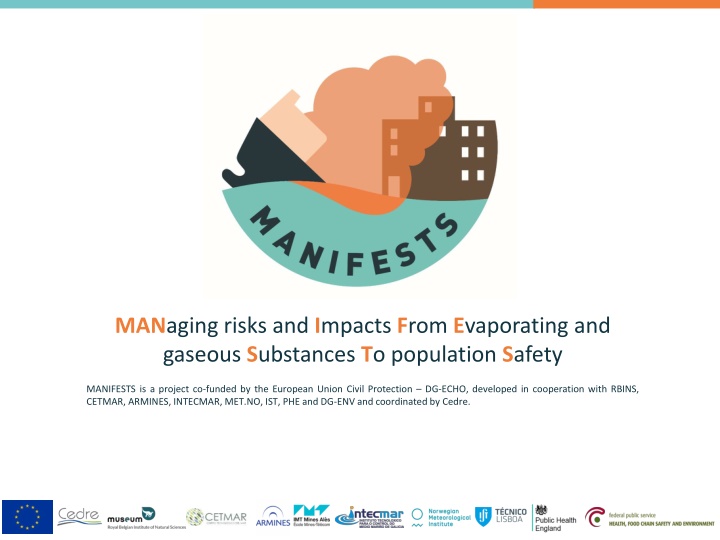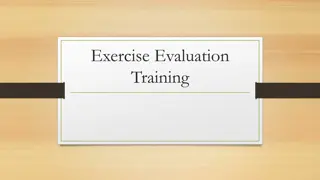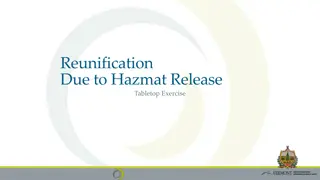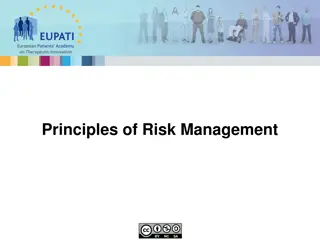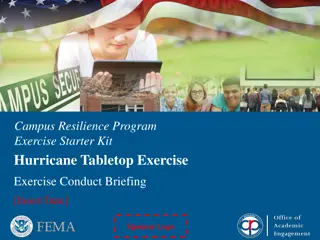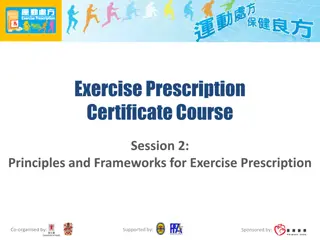Enhancing Population Safety Through Risk Management and Exercise Planning
MANaging risks and impacts from evaporating and gaseous substances to population safety is a project co-funded by the European Union Civil Protection, focusing on exercise programming, program management principles, and general guidelines for planning exercises. It emphasizes the importance of setting clear objectives, maintaining cooperation with relevant organizations, and conducting regular evaluations to ensure improvements and preparedness.
Download Presentation

Please find below an Image/Link to download the presentation.
The content on the website is provided AS IS for your information and personal use only. It may not be sold, licensed, or shared on other websites without obtaining consent from the author.If you encounter any issues during the download, it is possible that the publisher has removed the file from their server.
You are allowed to download the files provided on this website for personal or commercial use, subject to the condition that they are used lawfully. All files are the property of their respective owners.
The content on the website is provided AS IS for your information and personal use only. It may not be sold, licensed, or shared on other websites without obtaining consent from the author.
E N D
Presentation Transcript
MANaging risks and Impacts From Evaporating and gaseous Substances To population Safety MANIFESTS is a project co-funded by the European Union Civil Protection DG-ECHO, developed in cooperation with RBINS, CETMAR, ARMINES, INTECMAR, MET.NO, IST, PHE and DG-ENV and coordinated by Cedre.
Co-funded by the European Union Civil Protection Exercise programming and planning
Why exercising? Exercise programming is a permanent activity, involving the construction of a series of coordinated and integrated exercise activities over time. Modified from Homeland Security Exercise and Evaluation Program (HSEEP) (FEMA, 2020) Co-funded by the European Union Civil Protection
Why exercising? Exercise programming is a permanent activity, involving the construction of a series of coordinated and integrated exercise activities over time. Contingency plan Programmes should be reviewed depending on the needs determined within contingency plans. Modified from Homeland Security Exercise and Evaluation Program (HSEEP) (FEMA, 2020) Co-funded by the European Union Civil Protection
Programme management principles Assign a programme manager responsible for tracking implementation of improvements. Set programme s objectives (ex: regulation, organization, communications, planning ) Develop plans of exercise and training activities. Maintain cooperation with relevant organizations; Produce a periodic progress report which demonstrates improvements assigned to each organization and how exercises implement improvement actions. Organize administration of resources. Co-funded by the European Union Civil Protection
General guidelines before planning Ensure that senior managers support and approve the activities. Analysis of needs to lay the foundations for all subsequent development. Set only clear, realistic and measurable objectives. Acknowledge that exercises are made to improve, not to impress. Keep exercises simple and more frequent for faster improvements. Plan complex exercises only when personnel are experienced and once objectives of the more simple are reached. Remember the importance of a successful evaluation: Valid, Authentic, Current, Sufficient and Reliable (VACSR). Take into account changes in staff and equipment since previous exercises. Co-funded by the European Union Civil Protection
1. Select exercise type 2. Exercise planning process Analysis Design Preparation Development Implementation Execution Evaluation Review Co-funded by the European Union Civil Protection
Modified from Introduction to the Exercise Planning Tool (WHO, 2021) and adapted to the MANIFESTS Exercise Tool 1. Select exercise type What you want to do? Test an organization s capability/ structure Present or discuss something new Indoors Exercise run in a room or rooms. Outdoors Exercise run in a room/ rooms and/or in the field with deployment of means. Requires interaction from participants? Do you want to deploy equipment? Test an emergency plan/policy No Yes Test a specific component / function Test an emergency plan/policy No Yes No Yes Modifiable scenario Fixed scenario Seminar Workshop Serious game Table top Functional exercise Drill Full-scale exercise Co-funded by the European Union Civil Protection
2. Exercise planning process Design Analysis Development Evaluation Implementation Co-funded by the European Union Civil Protection
Analysis Go to Types of exercises Set exercise planning group All agencies who have a role to play should be invited. The exercise planning group can include exercise facilitators and evaluators, but should not include players. Exercise planning groups and meetings can range from one person and/or meeting to several, depending on the complexity and type of the exercise. Set exercise planning meetings Concept and Objectives Initial Planning Midterm Planning Storyboard of the incident, injects and documentation Final Planning Co-funded by the European Union Civil Protection
Design Set objectives (SMART: Specific, Measurable, Achievable, Relevant/Realistic, Timely) Appoint exercise coordinator and team Establish exercise scope (select type, participants, duration, location, parameters) Establish exercise plan (details of type, participants, roles, duration,location, parameters, previoustraining). Establish exercise resources (equipment, devices for communications, hardware and software, units, rooms, operative requirements for the location/s ) Establish exercise scenario (realistic threat, challenging but posible) Establish the evaluation plan. Roadmap to implement the lessons learnt. Determine media and public relations guidance Obtain aproval for proposal and design from senior managers Co-funded by the European Union Civil Protection
Development Establish coordination team and coordination plan Develop exercise scenario Develop training and related activities (needed to develop the exercise), train the exercise trainers Develop exercise documentation (briefingreport, injects, evaluationforms ) Prepare administration, materials and approval Prepare logistics (meeting rooms, food, audiovisual equipment, note-taking supplies, badges, registration assistance, directions, parking ) Prepare and test technical resources (equipment, devices for communications, hardware and software, connections, network ). Develop communications plan (media and external community relations) Prepare safety and security means Co-funded by the European Union Civil Protection
Adapted from Preparing Scotland Exercise Guidance (2018) Scenario considerations It should be realistic and include: Realistic timescale (day/s, date/s and time). Nature of incident (consistent with exercise location) Expected weather conditions Progression (different phases in complex exercises) Particularities of people involved (e.g. vulnerable, young, elderly) Activities for each organization and participant involved. A particular focus on injects and the flow of information -communications It is important that the scenario is well detailed (timeline, storyboard, injects) but storyboard may be to some extent flexible to permit participants deal with unplanned incidents. Some previous decisions: o o Time-lapse or real time. Controlled or free play. The scenario can be completely or partially pre-scripted, dependingif we want to test the flexibility or the validityof plans. Media. The exercise can include the participation of media to test their response. Also replicate Social Media feeds to include publicreaction. Co-funded by the European Union Civil Protection
Implementation Preparation (once all logistics are ready): Conduction: Briefing participants (players and observers) Management Team Briefing/Meeting: review of the entire exercise (scenario, documentation, equipment, functions, Familarisation with equipments (led by organisation team) flow of information, equipment, distribution ). Test equipments to make sure they work properly. Initiation play Maintaining the exercise Evaluating activities Terminating play Co-funded by the European Union Civil Protection
Evaluation Collect data (during and after exercise) Go to Debrief documentation Hot wash : critique held immediately after the exercise. Debriefing : more formal session to share more considered opinions. Feedback forms Analyse collected data Analyse events and facilities Report findings Of improvement for participants. Of improvement for future exercises. Make recommendations Proposal of itinerary of activities for individual participants or groups. Co-funded by the European Union Civil Protection
Adapted from Preparing Scotland Exercise Guidance (2018) Debrief considerations Give an introduction to explain why the debrief is useful. Be sure all participants have the necessary contact details to send information. Establish ground rules for example: Participants should be as frank and open as possible sharing their opinions and concerns. The debrief must be concentrated on key issues and priorities. Extra issues can be sent by email Confirm the outcomes of this debrief and feedback to participants Ask participants for: Weaknesses of the exercise Strengths of the exercise What they have learnt Good practices (strategies and/or activities that resulted effective and efficient) What they would recommend (areas for improvement) Which concerns they have Afterwards: Send additional debrief points by email to participants Send outcomes of this debrief and feedback to participants Co-funded by the European Union Civil Protection
References: Preparing Scotland Exercise Guidance (2022) Link GOV.UK. Emergency planning and preparedness: exercises and training (2022) Link DG ECHO. Technical Guide for UCPM Full-scale exercises (2021) Link FEMA (Federal Emergency Management Agengy). Course IS-120.C: An Introduction to Exercises (2018) Link IPIECA. Oil spill exercises, Good practice guidelines for the development of an effective exercise programme (2016) Link Arcopol Plus. Activity 3, Task 3.1.3: Guides for training forecasting exercises (2014). Link MCA UK (Marine Coastguard Agency) The Exercise Planners Guide (1998) Link IPIECA. A guide to oil spill exercise planning (1996) Link OMS/WHO Introduction to the Exercise Planning Tool (2021). Link Partners logo Co-funded by the European Union Civil Protection
